Circuit-Zone.com - Electronic Projects
Posted on Friday, October 14, 2022 • Category: Miscellaneous

Modern model railroads are digitally controlled using a Digital Command Control (DCC) protocol similar to network packets. These data packets contain device address and instruction set that is embedded in the form of AC voltage and fed to train track to control locomotives. The great advantage of DCC over analog DC control is that you can independently control the speed and direction of many locomotives on the same train track as well as control many other lights and accessories using that same signal and voltage. Commercial DCC decoders are available on the market however their cost can add up pretty quickly if you have a lot of devices to control. Luckily you can build a simple Arduino DCC decoder yourself to decode DCC signal and control up to 17 LEDs / accessories per each DCC decoder.
Posted on Wednesday, November 18, 2020 • Category: Miscellaneous
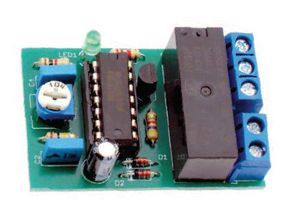 Build an adjustable auto power On Off delay timer circuit using CD4541 timer. This electronic timer circuit is helpful when you need to power On/Off any AC Appliances after a pre-defined duration. Delay time it can be adjusted from about 2 to 120 seconds.
Posted on Friday, June 14, 2019 • Category: Miscellaneous
 This is a simple arduino project for a soil moisture sensor that will light up a LED at a certain moisture level. It uses Arduino Duemilanove microcontroller board. Two wires placed in the soil pot form a variable resistor, whose resistance varies depending on soil moisture. This variable resistor is connected in a voltage divider configuration, and Arduino collects a voltage proportional to resistance between the 2 wires.
Posted on Sunday, August 17, 2014 • Category: Miscellaneous
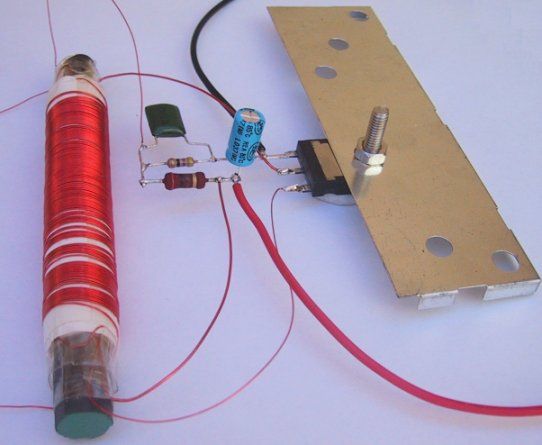 This is a low voltage 12V fluorescent inverter for powering two 20W or single 40W fluorescent tube. It's a circuit you can put together from junk box components and is a very simple to build. The transformer is hand-wound on a ferrite rod from an old transistor radio and the winding wire can be salvaged from an old transformer. The cost of powering the circuit is about 22 watts and this will produce the same light output as 60 watt incandescent light bulb.
Posted on Thursday, July 24, 2014 • Category: Miscellaneous
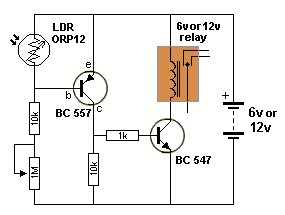 This circuit automatically turns on the light through a relay when daylight intensity falls below a preset level on the Light Dependent Resistor (LDR).
Posted on Sunday, June 22, 2014 • Category: Miscellaneous
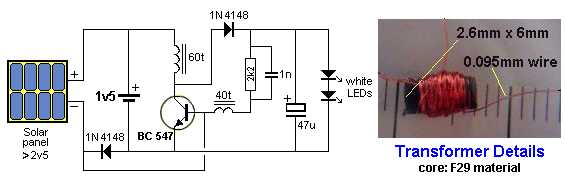 This circuit automatically turns on and illuminates the LEDs when the solar panel does not detect any light. It switches off when the solar panel produces more than 1v and charges the battery when the panel produces more than 1.5v + 0.6v = 2.1v.
Posted on Sunday, June 1, 2014 • Category: Miscellaneous
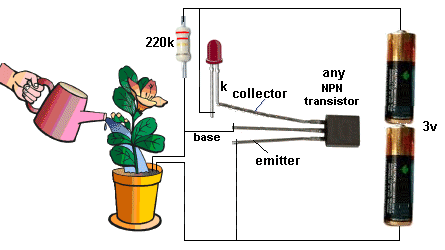 This simple plant water alarm circuit indicates when the soil is dry and the plant needs watering. The circuit does not have a current-limiting resistor because the base resistor is very high and the current through the transistor is only 2mA. Replacing 220K resistor with 1M potentiometer will provide adjustment when the alarm should be triggered depending on the moisture left in the soil.
Posted on Tuesday, May 13, 2014 • Category: Miscellaneous
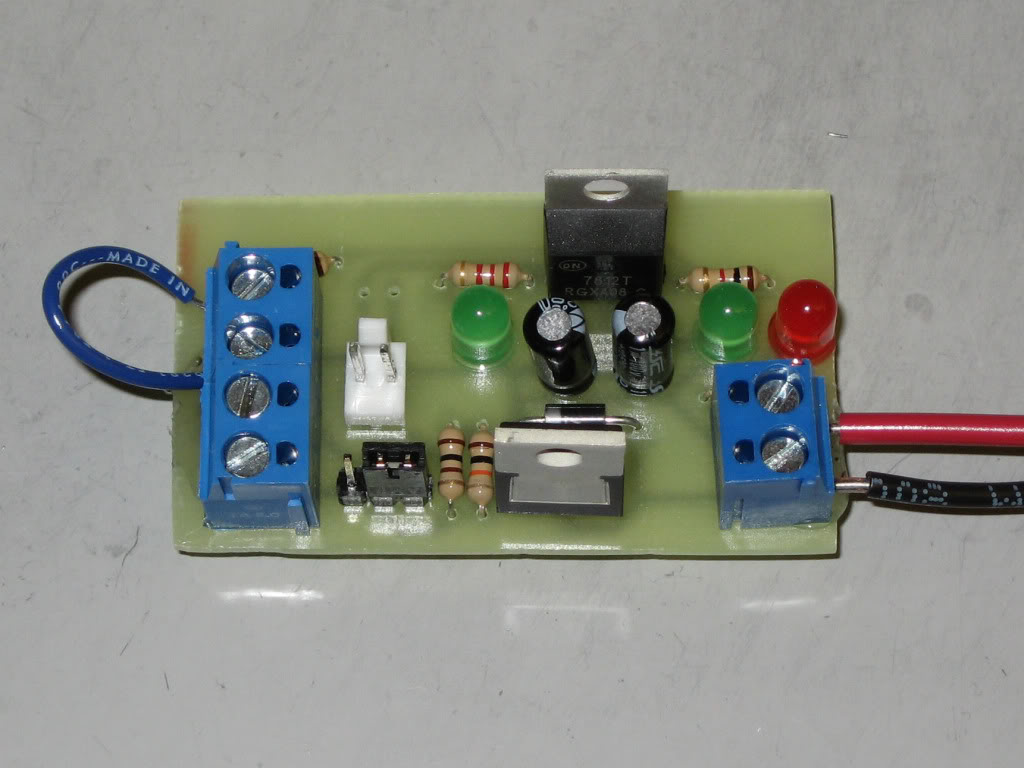 Constructing a MOSFET switch is one of the basic level electronics projects and could be useful for beginners to get a hang of the various FET transistors. The aim of this project is to make control a heavy duty DC load by constructing a simple switch. MOSFET transistors are capable of handling a large voltage and current. It is because of this feature that it is being much sought after for connecting heavy loads to a circuit or a microcontroller.
Posted on Monday, July 18, 2011 • Category: Miscellaneous
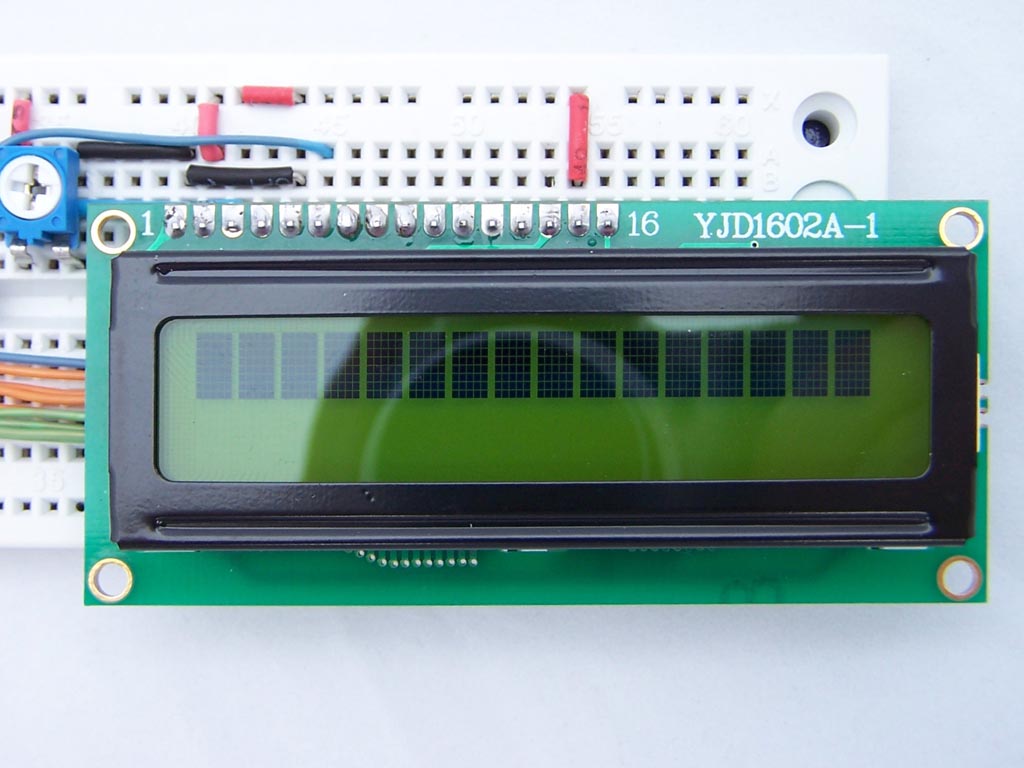 LCD character displays can be found in espresso machines, laser printers, children’s toys and maybe even the odd toaster. The Hitachi HD44780 controller has become an industry standard for these types of displays. This tutorial will teach you the basics of interfacing with a HD44780 compatible display using some DIP switches and a few other components.
Posted on Tuesday, May 31, 2011 • Category: Miscellaneous
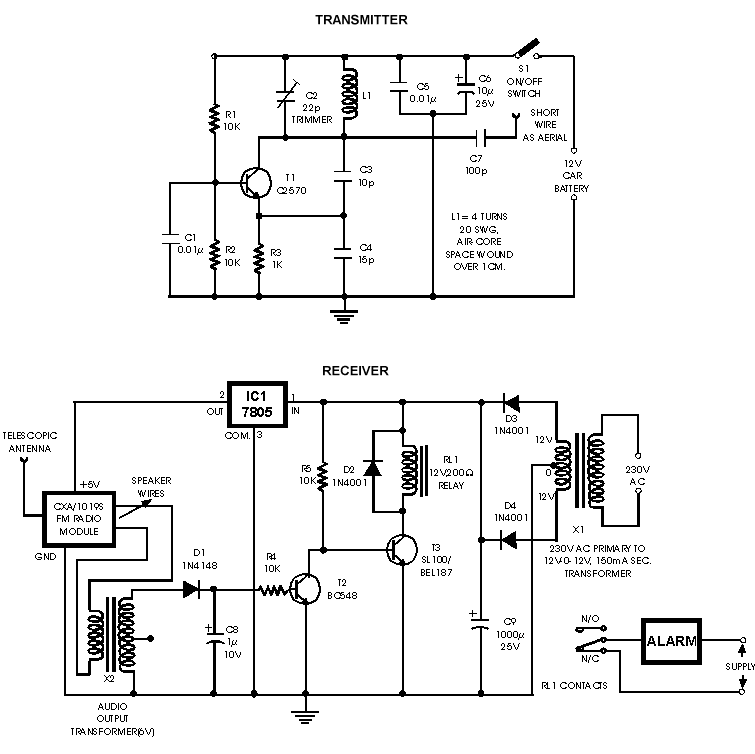 Alarm circuit is functioning as a car wireless security alarm. Yes, this is an FM radio-controlled anti-theft alarm. This alarm can be used on any vehicle that has a DC power supply 6-12V.
Alarm circuit system is divided into two parts, the transmitter unit and receiver unit. Transmitter unit is working on the range of VHF Band II, exactly at a frequency of 88-108 MHz. This transmitter is a miniature FM transmitter that is installed in vehicles at night while parked in the car porch or car park.
Posted on Tuesday, May 24, 2011 • Category: Miscellaneous
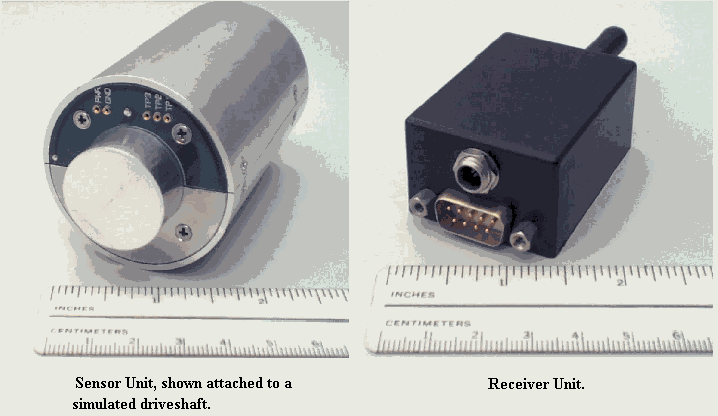 This device is designed to measure the torque in an automobile drive shaft and provide an output to a vehicle data recording system or a portable computer via an RS-232 interface. The received data can then be combined with RPM measurements from the data recording system to calculate horsepower. It consists of the sensor unit, (Figure 1), which attaches to the driveshaft, and the receiver unit, , which provides the serial output signal. The sensor unit is battery powered and communicates with the receiver via a 433 Mhz RF data link.The receiver unit is powered by the vehicle electrical system. Circuit operation is shown in the diagram.
Posted on Sunday, May 22, 2011 • Category: Miscellaneous
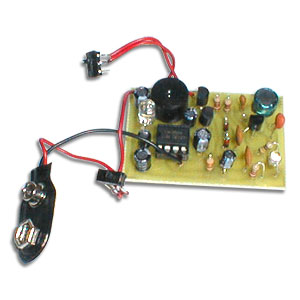 This DIY lightning detector circuit is a very sensitive static electricity detector that can provide an early warning of approaching storms from inter-cloud discharge well before an earth-to-sky return strike takes place. An aerial (antenna) formed of a short length of wire detects storms within a two mile radius.
The circuit emits an audible warning tone from a piezo buzzer, or flashes an LED for each discharge detected, giving you advance warning of impendig storms so that precautions may be observed.
Posted on Saturday, April 16, 2011 • Category: Miscellaneous
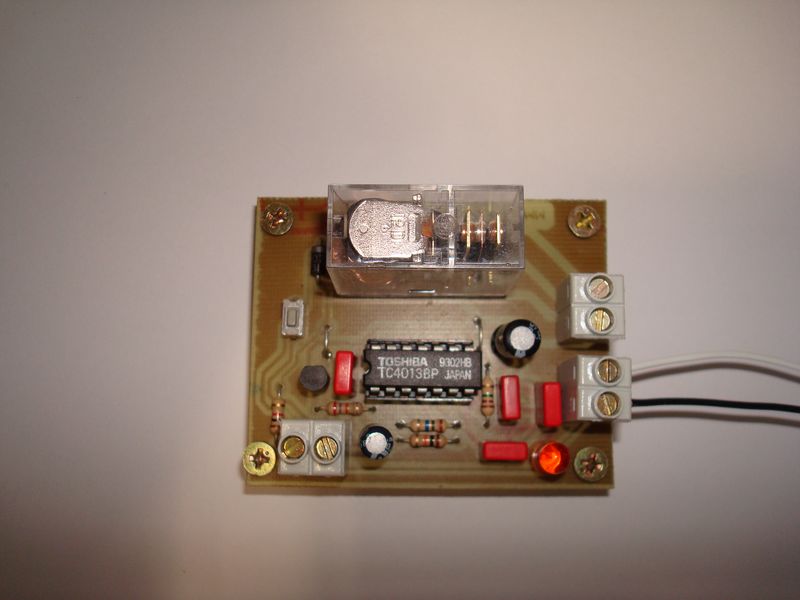 Small circuit, with which we can use to get rid of the standard switch and operate any type of load with a push of a tactile button. Voltage between 5 and 18 V DC ( depends on the operating voltage of the relay coil ) in terminal CN1. Output Current is 10A ( depends on relay contacts ) in terminal CN3 activated by external positive pulse or short-circuiting the terminal CN2. Circuit is protected against double pulses and rebounds.
Posted on Friday, April 8, 2011 • Category: Miscellaneous
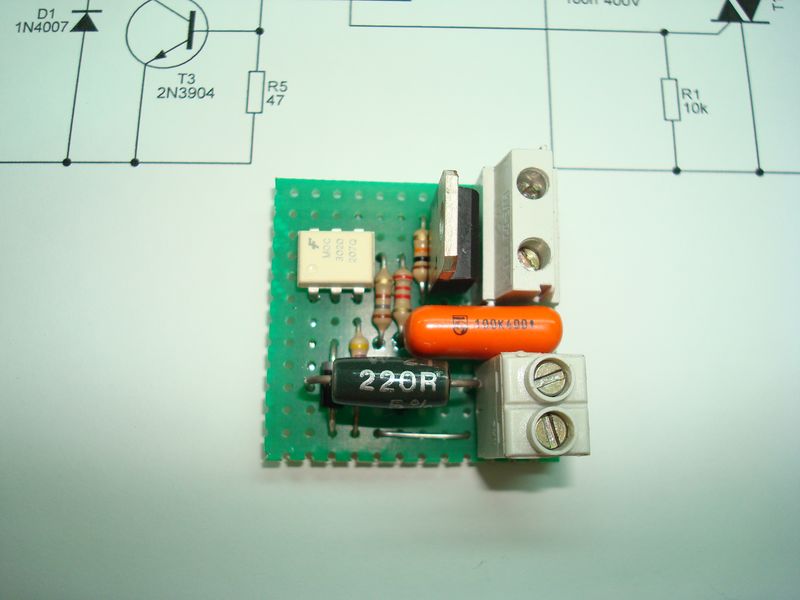 Solid state relay is a hybrid circuit, normally composed of an optocoupler which isolates the input, a trigger circuit that detects the zero crossing of the line current and a triac or similar device that acts as a circuit breaker. Its name comes from the similarity presents an electromechanical relay, this device is generally used for applications which has a continuous use of the contacts of the relay compared to a conventional relay generate a serious mechanical wear, besides being able to switch high amperage in the case of electromechanical relays in a short time would destroy the contacts. These relays allow switching speeds much higher than the electromechanical relays.
Posted on Monday, April 4, 2011 • Category: Miscellaneous
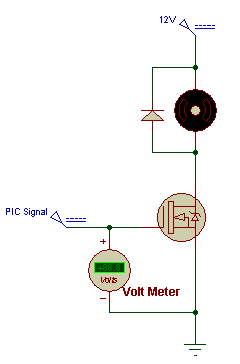 MOSFET transistors are excellent choice for driving high current devices such as motors or high power RGB LEDs. They offer very low switching resistance and very small heat dissipation compared to bipolar transistors. This guide is designed to explain how to drive N-Channel MOSFETs with a microcontroller such as PIC or ATMEGA. Transistors heat up when driving large loads because they have a voltage dropped over them (Vce), and Heat (Watts) = Voltage * Current. This leads to thermal runaway within the transistor, eventually driving the device to destruction if not handled carefully.
FET's are like digital switches, capable of turning on and off between the Drain and Source via a voltage potential at the Gate. When a FET is on, it usually has a resistance of less than 0.01 ohm, and when off, its like an open circuit. Because of the low resistance during the FET's on state, it can allow large amounts of current to pass through it without heating up.
FET's turn on by voltage potential, not an electric current, and in return they have a very high input impedance. With this in mind, you only need a voltage to turn them on, perfect for digital electronics.
Posted on Monday, April 4, 2011 • Category: Miscellaneous
 Here's a simple microphone amplifier based around TDA7050 IC. There are many schematics, the choice fell on the amplifier chip TDA7050, the only downside was it that it was not appointed to the microphone. By adding a resistor R1 in the scheme by 4,7 kOhm - amplifier can no longer work with conventional condenser microphones.
If you remove the resistor R3 - the alarm will be put on a small speaker with an impedance of winding 32 Om'a.
Voltage amplifier is powered by 3 - 5 volts, but as the amplifier must be nourished from 12 in the scheme of linear stabilizer was added at 5 V.
This scheme was checked with headphones (current consumption was 50 mA) and connect to the line input of your TV.
Posted on Saturday, March 26, 2011 • Category: Miscellaneous
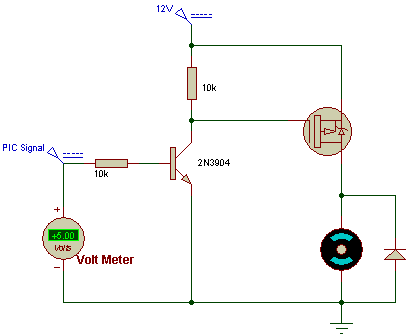 MOSFET transistors are excellent choice for driving high current devices such as motors or high power RGB LEDs. They offer very low switching resistance and very small heat dissipation compared to bipolar transistors.
This guide is designed to explain how to drive P-Channel MOSFETs with a microcontroller such as PIC or ATMEGA. There are a couple of tricks to remember when using them. P-Channel MOSFETs are useful for switching positive supply of a target circuit on and off. Particular attention must be placed to the target circuit if the supply voltage is greater then the micro controller's logic voltages.
If for example, your target device is being powered by 12 volts, and your logic high state from the micro controller is 5 volts, then the MOSFET will never turn off, as voltage will either be -12V or -7V (remember that this guide is designed for logic level MOSFETs). Anything over -3 volts will generally drive the logic level MOSFET on (varies between types of LL MOSFETs).
Posted on Wednesday, March 23, 2011 • Category: Miscellaneous
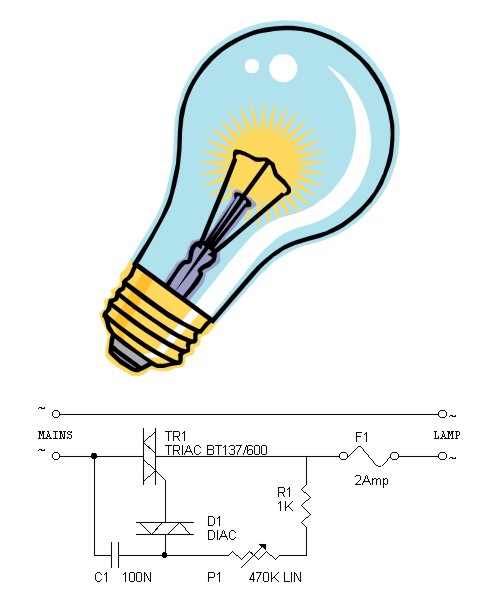 This simple lamp dimmer uses only a Triac, a Diac and some other passive components to achieve power control on lamp . It is suitable for 230V incandescent lamps with a total power of up to 300 Watts. At first triac TR1 is not conducting; C1 is charged through R1/P1 until the trigger level of diac D1 is reached. When the diac trigger level is reached (about 30 V), D1 fires and Triac TR1 is switched on. The triac will remain in conductive mode until the mains current is lower than the triac hold current at the end of the half mains period. This works for both the negative and positive mains period because both the triac and the diac are bi-directional. R1 is added to protect the potentiometer in the case of a short circuit. The fuse is absolutely mandatory as the discharge arc in a failing incandescent lamp is virtually a short circuit.
Posted on Monday, March 21, 2011 • Category: Miscellaneous
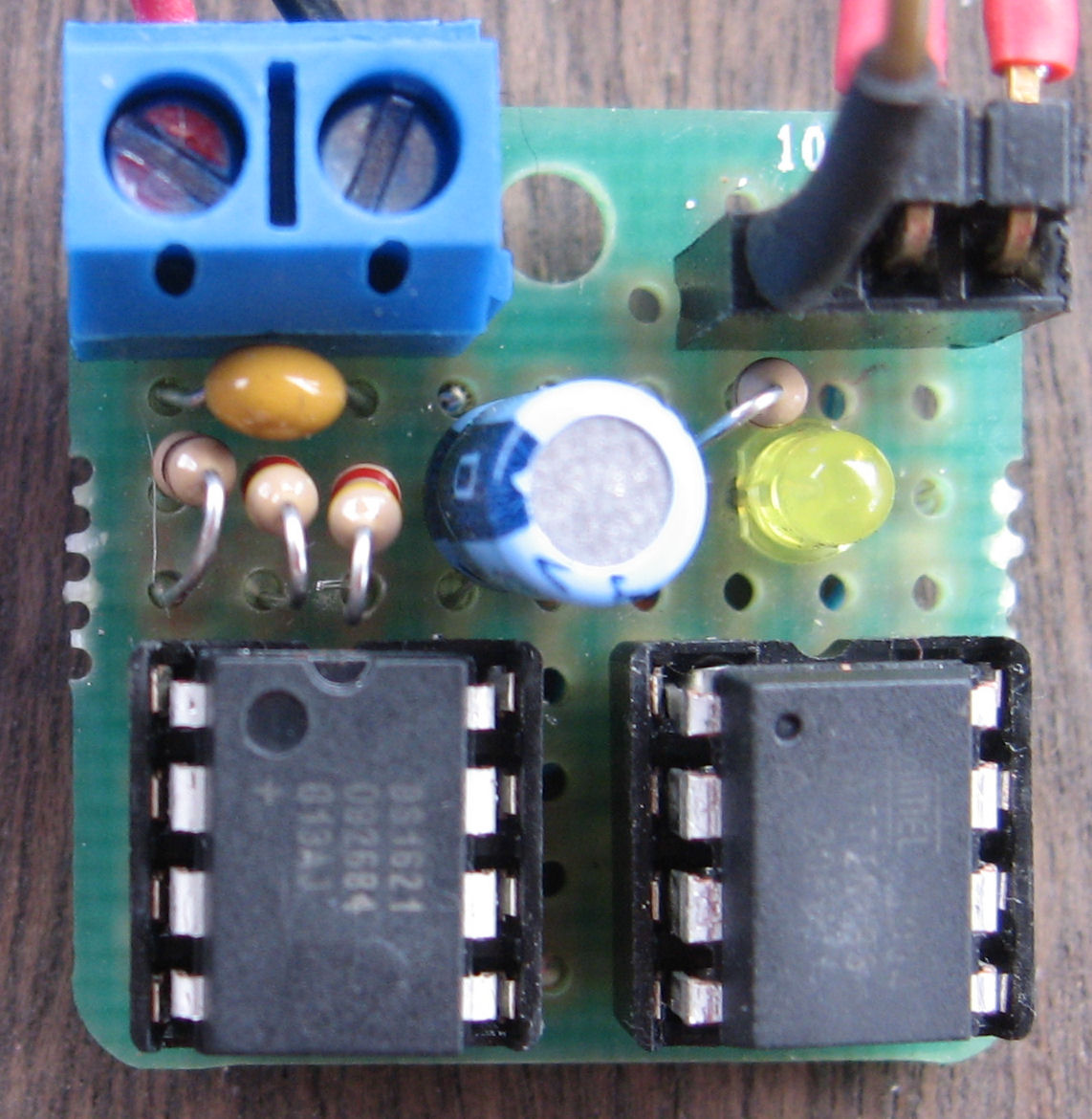 I became interested in the ATtiny85 processor recently. Up till now, my projects were based on the ATmega328 or the ATmega644. The ATtiny85 is just that, tiny - only 8 pins vs. 28 on the ATmega328. The photo on the left shows the new X10 temperature transmitter, with the DS1621 temperature chip on the left and the ATtiny85 on the right.
Posted on Tuesday, March 15, 2011 • Category: Miscellaneous
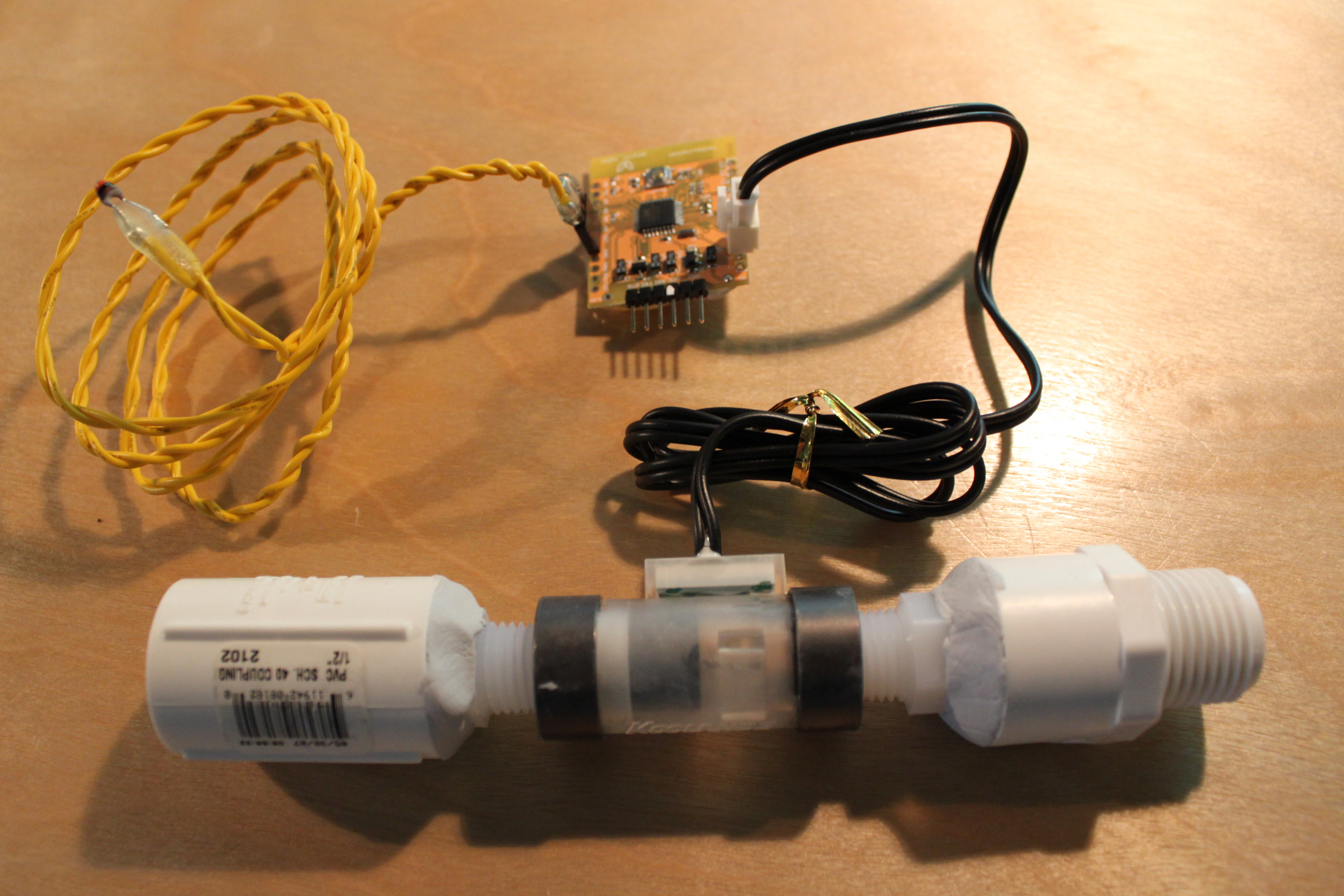 Working with the interaction design team, a bunch of us at Teague have been tinkering with measuring water, analyzing usage data in realtime to affect behaviors, and storing it to see patterns over time.
At the heart of the exploration was a need to cheaply measure water from the tap. Water meters vary quite drastically in price (from $250+ for industrial grade sensors to $6 for garden hose attachments that limit total usage based on rough estimates). We settled on a $20 water meter used for PC cooling systems (the INS-FM17N by Koolance) due to its accuracy, low price, small size, and electronic sensing method that could be easily measured by a microcontroller (such as an Arduino).
Posted on Tuesday, March 15, 2011 • Category: Miscellaneous
 I made a relatively simple attachment to my Canon SLR to create a motion activated camera using Arduino. A lot of this was based on and inspired by the intervalometer project at The Honey Jar. I made some changes to his circuit to use a 4N35 optocoupler instead of reed relays.
Posted on Tuesday, March 15, 2011 • Category: Miscellaneous
 Every group wants their final project to be something that will be remembered long after they're gone. Some do highly sophisticated and complex projects that entail upwards of a hundred hours to complete. Yet others go out of their way to develop something 'cool' and 'fun'. Luke and I decided that we wanted to be in this second category, because developing something that's 'cool' would also be fun to do. So in deciding what to design we tried to think of something that would catch the attention of the people in the lab. The easiest way of doing this is to create something that would make noise or play music so everyone in the lab could enjoy it. Realizing this would be the best way to go, we decided to create a synthesizer that could record and playback notes, 'teach' the user how to play a simple melody, and also play some prerecorded tunes. After all, don't you think being remembered as the group that played back the Imperial March theme from Star Wars is cooler than a paper tape reader? (no offense to those groups doing paper tape readers)
Posted on Thursday, January 20, 2011 • Category: Miscellaneous
 Solid State Relays are available almost everywhere these days, however they remain very expensive. Therefore, your efforts to build one yourself pays off. Especially since it only needs a handful components and the circuitry is simple and straightforward. A Solid State Relay is actually not a relay at all. There is no 'relay' present, just the electronics which does the switching. It works the same way as a relay; you can use a low voltage to switch a higher voltage or better. This 'relay' is positioned in between one of the 115/220V AC wires although it is common practice to leave the neutral wire the way it is and switch the phase or hot wire.
Posted on Thursday, January 20, 2011 • Category: Miscellaneous
 This is a AC Control Input AC Output SSR Solid State Relay. When a Process Controller has an AC output or a system generates an AC signal of above 100V AC to signal the load to turn on, this device can be used. A BTA40-600 and MOC3041 are used in this. A high voltage plastic cap limits current to a bridge which generates a small DC from 230 V AC, this drives MOC3041. The rest is the same. It is better to use a DC control SSR where possible. This AC control SSR is used where only an AC control signal is available. The BTA series has the heatsink tab insulated from the Triac chip inside. The BTB needs electrical insulation to the heatsink.
Posted on Thursday, January 20, 2011 • Category: Miscellaneous
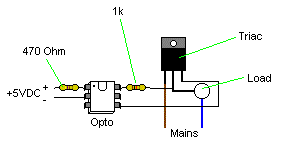 Solid state relays do the same thing (switch 110VAC), only electronically. They still have the "control pins" (where the coil would be if it were a relay) and the input and output pins of the switch. However, there isn't a coil inside. Remember we are talking about switching 110VAC here. Because of this, one has to select the solid state switch designed to accomplish this task. One can purchase these devices from many electronic parts stores. Remember to simply check the ratings and make sure you provide yourself with a safety margin. For example, if the part will handle up to 3 amps of current, don't run 3 amps. Instead run something like half that. This way no one will get hurt because of a device failure and the device will work longer than running it at it's maximum rating.
Posted on Thursday, January 20, 2011 • Category: Miscellaneous
 This circuit not only indicates the amount of water present in the overhead tank but also gives an alarm when the tank is full.
The circuit uses the widely available CD4066, bilateral switch CMOS IC to indicate the water level through LEDs.
Posted on Sunday, January 16, 2011 • Category: Miscellaneous
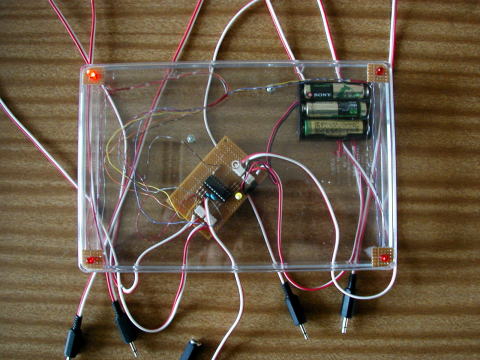 The HSR312 and HSR412 devices consist of a AlGaAs
infrared emitting diode optically coupled to a power
MOSFET detector which is driven by a photovoltaic generator.
The devices are housed in a 6-pin dual-in-line
package. The HSR312L and HSR412L employ an active
current limit circuitry enabling the device to withstand
current surge transients.
Posted on Saturday, January 15, 2011 • Category: Miscellaneous
 An opto-coupler is a device that can be used to electrically isolate two circuits, so that a voltage spike or other problem on one side will not destroy the circuit on the other side. A common use for them is when you want to interface a computer to an AC-powered device, such as a light or a motor. Usually, the opto-coupler will not be used to control the device directly, and instead will just transfer a signal from one circuit to another.
Posted on Monday, December 27, 2010 • Category: Miscellaneous
 Using the GPS Satellite system offers the advantage of very accurate timing and by extension, frequency control. The long term error is to all intents and purposes zero, with time and frequency accuracy being comparable to the international standard. The traditional route is to use a relatively low cost GPS receiver module which outputs a 1 Pulse per second signal (1 PPS) aligned to UTC. Basic GPS modules such as the Garmin GPS25 and Motorola Oncore have been around for some years and are available at low cost. It is possible to phase lock a divided down crystal oscillator to this 1 PPS signal and transfer its long term stability to , say, a 10MHz reference which is subsequently used for deriving any LO and beacon frequencies. The subsequent PLL system is usually described as a GPS Disciplined Oscillator rather than locked, since it is not, strictly speaking, actually ‘locked’ to the GPS system at all; just controlled by it via the 1 PPS generated by software in the receiver module.
Posted on Monday, December 27, 2010 • Category: Miscellaneous
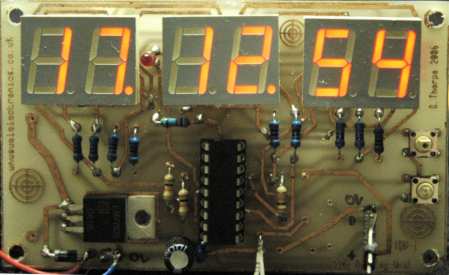 I decided to build a device to permanently display accurate time received from a cheap GPS module installed in my workshop.
Having obtained a PIC18F1320 microcontroller for experimentation, I wanted to learn about the new features of the PIC18F range using only minimal hardware to control the display.
I am currently using it with the on-chip 8Mhz oscillator only and driving a six digit led display, multiplexed with further saving of chip pins by a technique pioneered by Charlie Allen of Maxim-Dallas for their MAX6951 LED display drivers called “Charlieplexing” (see their application note AN1880).
I would have liked to have used a MAX6951 chip for better display brightness, but they appear to be only available in "Quarter Size Outline Packages" (QSOP) - the leads are very close together,not easy to experiment with.
Another alternative would be to use a MAX7219 display driver, this chip has a serial interface and an option to adjust the display brightness - something I may try later.
Posted on Monday, December 27, 2010 • Category: Miscellaneous
 The star is about 35cm across and designed to be displayed indoors in a window.
I originally created the star three years ago using a 16F872 controller. The original version worked ok - but had no spare memory for adding more features.
This new version uses a 18F2620 because I now prefer the 18F series and decided it would be a good general purpose 28 pin chip to use. It has more than enough memory (64K) so I can add as many features as I want now.
(It should also work using a PIC18F2525 instead if you find it easier or cheaper to obtain)
Since, I made the first version, brighter LEDs are now available and cost is much lower - this project currently uses a total of 60 comprising of 25 Blue, 15 Green and 20 Red.
Posted on Wednesday, December 15, 2010 • Category: Miscellaneous
 If you attempt to save power in the house thoroughly, you can not ignore the standby power consumption of appliances. We made a device to measure the power consumption of appliances. Actually, to say the AC power meters measure the 100V AC current is flowing in the power cord over do it. In general, the voltage is measured casually, is difficult to measure the current. To cut off a part of the circuit current flow from a current meter must be connected to it.
Posted on Wednesday, December 15, 2010 • Category: Miscellaneous
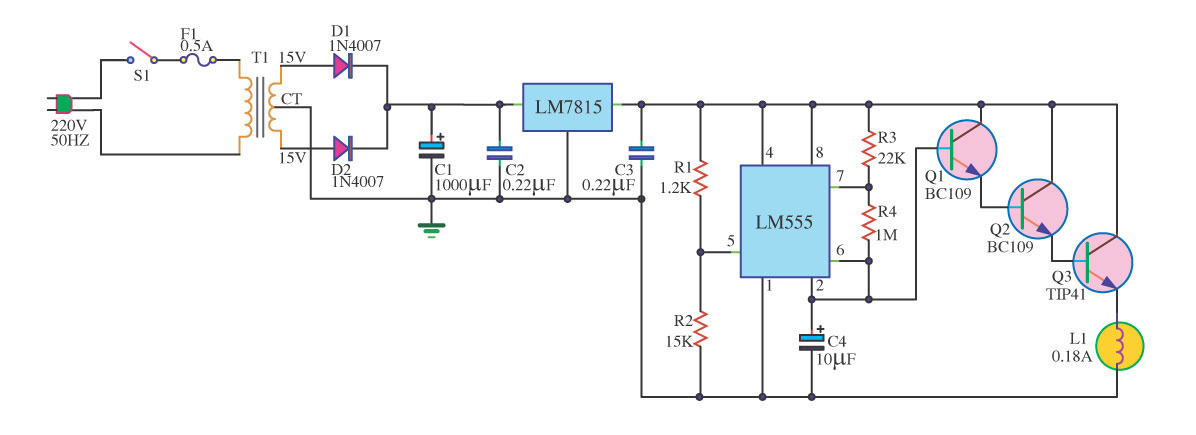 If you want a Power Lamp Flasher at normal electric power, try out Table Lamp Circuit like this is. It uses the integrated circuit NE555 as the core component. It controls the blink rate of the lamp. Use the power transistor for about 20W or current 1.6A. The Q3 can be replaced by TIP41 or H1061 or MJ3055 or 2N3055.
Posted on Wednesday, December 15, 2010 • Category: Miscellaneous
 Doorbell with 555 IC
Posted on Friday, December 3, 2010 • Category: Miscellaneous
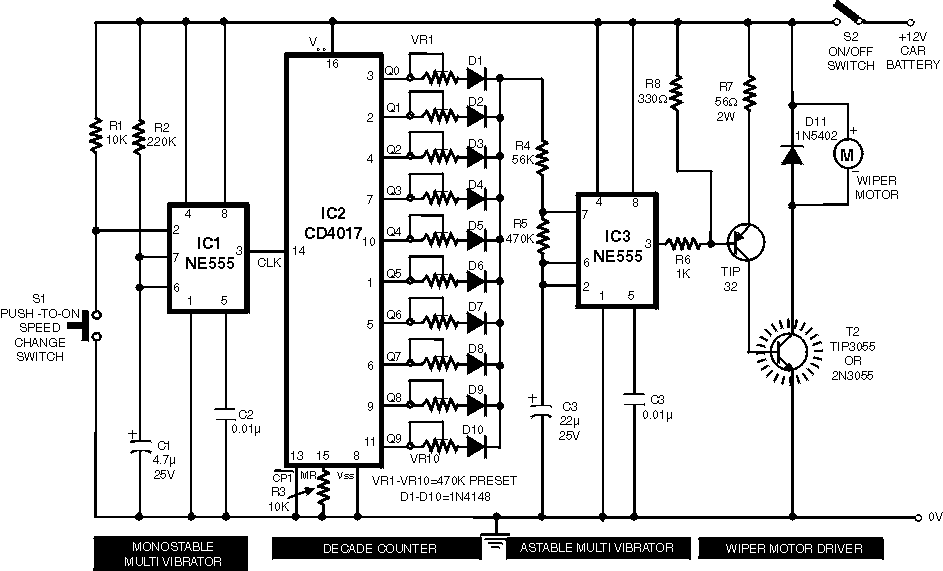 A continuously alive wiper in a car may prove to be a nuisance, abnormally back it is not aqueous heavily. By application the ambit declared actuality one can alter across-the-board amount of the wiper from already a additional to already in ten seconds. The ambit comprises two timer NE555 ICs, one CD4017 decade counter, one TIP32 disciplinarian transistor, a 2N3055 ability transistor (or TIP3055) and a few added detached components.
Posted on Friday, December 3, 2010 • Category: Miscellaneous
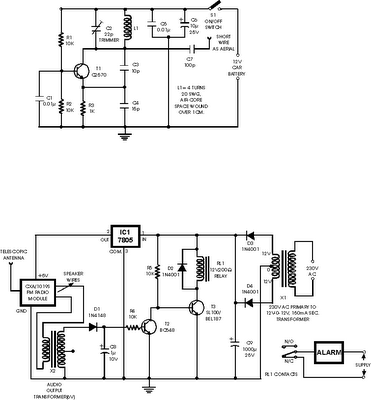 This is anti theft alarm with wireless connectivity ,called Anti Theft Car wireless alarm The FM radio-controlled anti- theft alarm can be used with any vehicle having 6- to 12-volt DC supply system. The mini VHF, FM transmitter is fitted in the vehicle at night when it is parked in the car porch or car park.
Posted on Wednesday, November 17, 2010 • Category: Miscellaneous
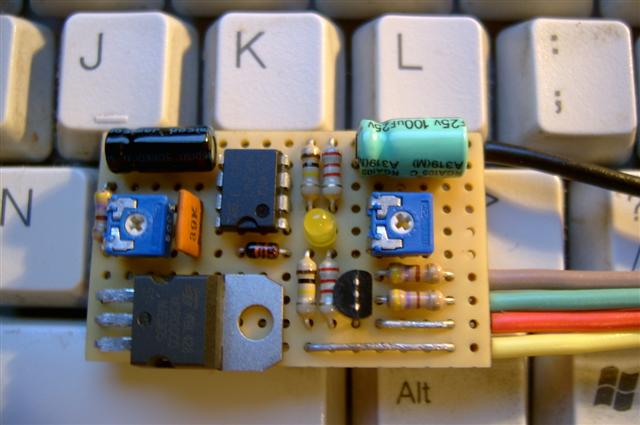 There are two stages: aboriginal one is dabbling and the additional one is fading. Back you accessible the aperture the ablaze turns on. You get central and abutting the door, but the ablaze stays on (delay stage) for an adjustable aeon of time (0-40 sec. for the ethics in the scheme, but you can calmly adapt that i.e. put a bigger capacitor) so you can see area to admit the key or do whatever you do back you get in the car, again fades abroad (fading stage) with an adjustable speed. If you affix the ACC wire (which is absolutely optional) back you about-face the key to ACC position the ablaze turns off (actually fades) alike if the dabbling date is not over (it cancels the adjournment stage).
Posted on Monday, November 15, 2010 • Category: Miscellaneous
 LCD display consists of an array of tiny segments known as pixels that can be manipulated to present information. As a result of this technology, many types of this displays are used in applications like calculator, watch, messaging boards, clock, equipments, machines and a host of other devices that one can think of. Most of the Display types are reflective, meaning that they use only ambient light to illuminate the display. Even displays that do require an external light source consume much less power than CRT devices.
Posted on Monday, November 15, 2010 • Category: Miscellaneous
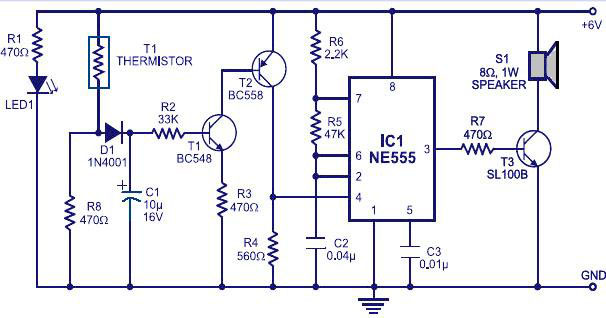 The thermistor offers a low resistance at high temperature and high resistance at low temperature. This phenomenon is employed here for sensing the fire.
The IC1 (NE555) is configured as a free running oscillator at audio frequency. The transistors T1 and T2 drive IC1. The output(pin 3) of IC1 is couples to base of transistor T3(SL100), which drives the speaker to generate alarm sound. The frequency of NE555 depends on the values of resistances R5 and R6 and capacitance C2.When thermistor becomes hot, it gives a low-resistance path for the positive voltage to the base of transistor T1 through diode D1 and resistance R2. Capacitor C1 charges up to the positive supply voltage and increases the the time for which the alarm is ON.
Posted on Friday, November 12, 2010 • Category: Miscellaneous
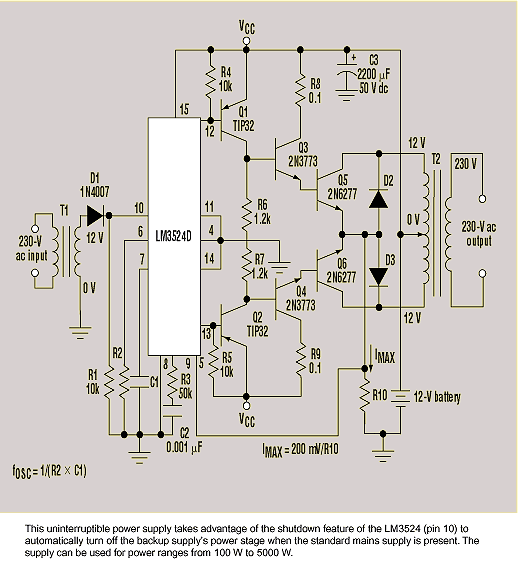 With increased dependency on electric power for various domestic, commercial purposes and the seemingly declining capacity of power utilities in many countries, the need for additional backup power sources is on the rise. Various modules are already available to address these different needs. However, most modules are too expensive, too bulky, or too rigid in their power capacity, capability, and flexibility.
The circuit described here is an off-line uninterruptible power supply. It has an expandable power stage design that can be easily modified for use with power ranges from as low as 100 W to as high as 5000 W with forced cooling.
Posted on Thursday, October 21, 2010 • Category: Miscellaneous
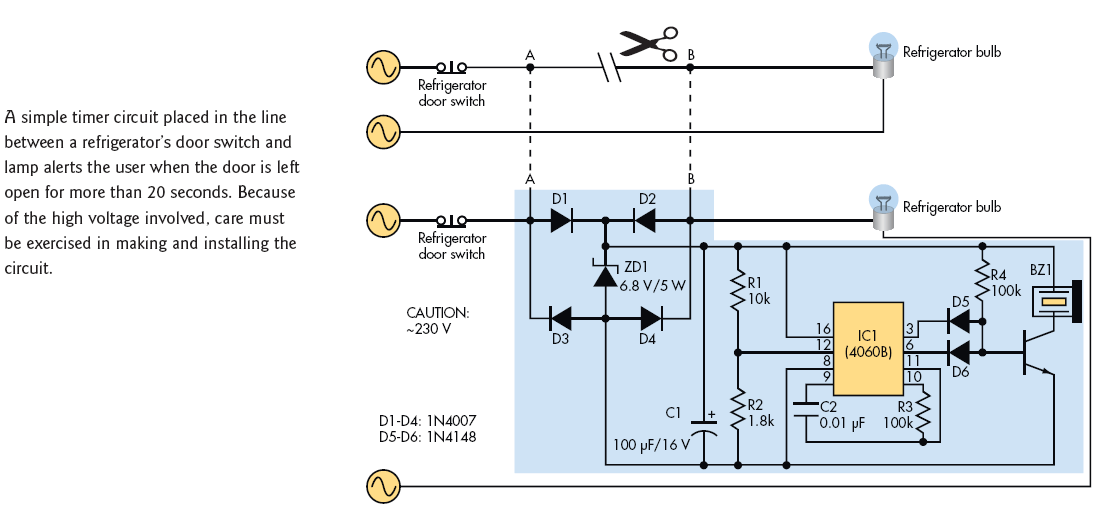 Not properly closing a refrigerator door will no doubt invite huge electricity bills. This gadget is an alert device that beeps if you leave the refrigerator door open for more than 20 seconds. When the door opens, the lamp illuminates and the IC (a 4060B counter/oscillator) starts counting down. After a preset delay of 20 seconds, the piezoelectric buzzer beeps intermittently for 20 seconds and then stops for the same amount of time. This cycle repeats until the refrigerator door closes.
Posted on Thursday, October 21, 2010 • Category: Miscellaneous
 Here is the circuit diagram of an ultrasonic mosquito repeller.The circuit is based on the theory that insects like mosquito can be repelled by using sound frequencies in the ultrasonic (above 20KHz) range.
Posted on Tuesday, October 19, 2010 • Category: Miscellaneous
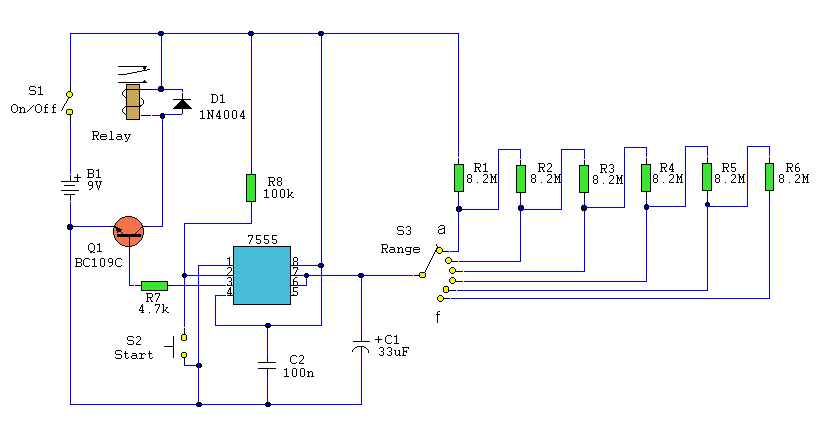 A switched timer for intervals of 5 to 30 minutes incremented in 5 minute steps. Simple to build, simple to make, nothing too complicated here. However you must use the CMOS type 555 timer designated the 7555, a normal 555 timer will not work here due to the resistor values. Also a low leakage type capacitor must be used for C1, and I would strongly suggest a Tantalum Bead type.
Posted on Tuesday, October 19, 2010 • Category: Miscellaneous
 This sensitive sound operated switch can be used with a dynamic microphone insert as above, or be used with an electric (ECM) microphone.
Posted on Monday, October 18, 2010 • Category: Miscellaneous
 It is fun to make a variable space in your small room, but it’s hard to make the actuator to move your wall or room partition. Using analog audio line delay, you can adjust your room virtually. Just turn a knob in your audio set and you can adjust your room size. The circuit described here will make your dream come true, giving a feel that your speaker is located 15 meters behind you, even though your room is actually 3 meters wide. Here is the circuit’s schematic diagram.
Posted on Monday, October 18, 2010 • Category: Miscellaneous
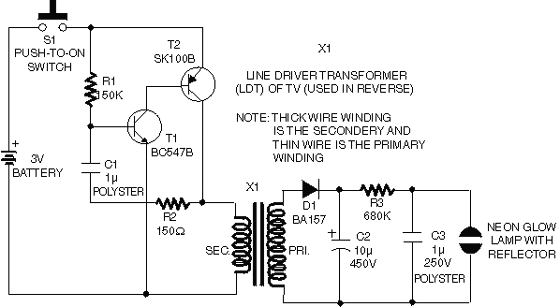 Strobe lights are widely used by disco lovers to create wonderful visual effects in disco halls and auditoriam. The circuit of a battery operated portable miniature strobe light, which can be constructed using readily available inexpensive components, is described here. For convenience and simplicity, an ordinary neon lamp is used here in place of the conventional Xenon tube.
Posted on Monday, October 18, 2010 • Category: Miscellaneous
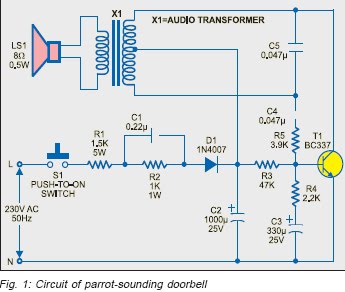 Here is a mains-operated doorbell that produces parrot-like sweet voice without requiring any musical IC. The circuit is cheap and easy to construct. The AC mains is fed to the circuit without using any step-down transformer.
Posted on Thursday, May 20, 2010 • Category: Miscellaneous
This electronic speed control (ESC) for brushed motors combines the features of two of my earlier designs. One was a high-rate 30A ESC with a brake, and the other a high-rate 12A ESC with a BEC (receiver battery eliminator circuit).
Posted on Friday, April 23, 2010 • Category: Miscellaneous
This small realization, based on one of the most common IC (MAX232) is designed to create a small and convenient TTL to RS232 and vice versa converter.
All you need is 4 caps, one IC and 2 connectors. If you want to add a small regulator on the board (already foreseen on the PCB) you just need to add a 78L05 regulator and a cap.
Circuit-Zone.com © 2007-2025. All Rights Reserved.
|
|
|